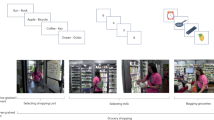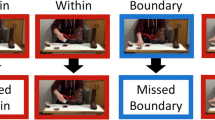Abstract
Recent studies suggest that episodic memory represents the continuous flow of information that constitutes daily life events in a temporally compressed form, but the nature and determinants of this compression mechanism remain unclear. In the present study, we used wearable camera technology to investigate whether the temporal compression of experience in episodic memory depends on event segmentation. Participants experienced a series of events during a walk on a university campus and were later asked to mentally replay these events. The temporal compression of events in memory and grain size of event segmentation were estimated based on records of participants’ experience taken by the camera. The results showed that the temporal compression of events in memory (i.e., the density of recalled moments of experience per unit of time of the actual event duration) closely corresponded to the grain size of event segmentation. Specifically, grain sizes of event segmentation and temporal compression rates were four to five times lower when remembering events that involved goal-directed actions compared to other kinds of events (e.g., spatial displacements). Furthermore, temporal compression rates in memory were significantly predicted by the grain size of event segmentation and event boundaries were more than five times more likely to be remembered than other parts of events. Together, these results provide new insights into the mechanism of temporal compression of events in episodic memory.




Similar content being viewed by others
Notes
In the present article, we use to terms “event segmentation”, “segmentation points” or “event boundaries” to refer to the events and sub-events identified in this event segmentation task, whereas as noted above the term “experience unit” refers to the moments of past experience that constitute episodic memories.
During the segmentation task, each picture was presented on the screen for a relatively short duration (i.e., 500 ms) and pilot tests showed that this sometimes led participants to select a picture that was 1 or 2 pictures before or after the actual segmentation point because they pressed the button too early or too late during the sequence. Consequently, we used a 5-picture window (rather than a single picture) to delimit segmentation points in these analyses.
References
Arnold, A., Iaria, G., & Ekstrom, A. D. (2016). Mental simulation of routes during navigation involves adaptive temporal compression. Cognition, 157, 14–23.
Baird, J. A., & Baldwin, D. A. (2001). Making sense of human behavior: Action parsing and intentional inference. In B. F. Malle & L. J. Moses (Eds.), Intentions an intentionality: Foundations of social cognition (pp. 193–206). Cambridge: MIT Press.
Bonasia, K., Blommesteyn, J., & Moscovitch, M. (2016). Memory and navigation: Compression of space varies with route length and turns. Hippocampus, 12, 9–12.
Brownstein, A. L., & Read, S. J. (2007). Situation models and memory: The effects of temporal and causal information on recall sequence. Memory, 15(7), 730–745.
Brunec, I. K., Moscovitch, M., & Barense, M. D. (2018). Boundaries shape cognitive representations of spaces and events. Trends in Cognitive Sciences, 22(7), 637–650.
Clewett, D., & Davachi, L. (2017). The ebb and flow of experience determines the temporal structure of memory. Current Opinion in Behavioral Sciences, 17, 186–193.
Conway, M. A. (2005). Memory and the self. Journal of Memory and Language, 53, 594–628.
Conway, M. A. (2009). Episodic memories. Neuropsychologia, 47(11), 2305–2313.
Dubrow, S., & Davachi, L. (2013). The influence of context boundaries on memory for the sequential order of events. Journal of Experimental Psychology: General, 142(4), 693–700.
Ezzyat, Y., & Davachi, L. (2011). What constitutes an episode in episodic memory? Psychological Science, 22(2), 243–252.
Faber, M., & Gennari, S. P. (2015a). In search of lost time: Reconstructing the unfolding of events from memory. Cognition, 143, 193–202.
Faul, F., Erdfelder, E., Lang, A.-G., & Buchner, A. (2007). G*Power 3: A flexible statistical power analysis program for the social, behavioral, and biomedical sciences. Behavior Research Methods, 39(2), 175–191.
Field, A. P., & Wilcox, R. R. (2017). Robust statistical methods: A primer for clinical psychology and experimental psychopathology researchers. Behaviour Research and Therapy (in press).
Flores, S., Bailey, H. R., Eisenberg, M. L., & Zacks, J. M. (2017). Event segmentation improves event memory up to 1 month later. Journal of Experimental Psychology: Learning, Memory, & Cognition, 43(8), 1183–1202.
Goldstein, H. (2011). Multilevel statistical models (4th ed.). Chichester: Wiley.
Hanson, C., & Hirst, W. (1989). On the representation of events: A study of orientation, recall, and recognition. Journal of Experimental Psychology: General, 118(2), 136–147.
Hard, B. M., Recchia, G., & Tversky, B. (2011). The shape of action. Journal of Experimental Psychology: General, 140(4), 586–604.
Horner, A. J., Bisby, J.A., Wang, A., Bogus, K., Burgess, N. (2016). The role of spatial boundaries in shaping long-term event representations. Cognition, 154, 151–164
Jeunehomme, O. & D’Argembeau, A. (2018). The time to remember: temporal compression and duration judgments in memory for real-life events. Quarterly Journal of Experimental Psychology. https://doi.org/10.1177/1747021818773082 (in press)
Jeunehomme, O., Folville, A., Stawarczyk, D., Van der Linden, M., & D’Argembeau, A. (2018). Temporal compression in episodic memory for real-life events. Memory, 26(6), 759–770.
Kurby, C. A., & Zacks, J. M. (2008). Segmentation in the perception and memory of events. Trends in Cognitive Sciences, 12(2), 72–79.
Lassiter, G. D., Stone, J. I., & Rogers, S. L. (1988). Memorial consequences of variation in behavior perception. Journal of Experimental Social Psychology, 24, 222–239.
Magliano, J. P., Radvansky, G. A., Forsythe, J. C., & Copeland, D. E. (2014). Event segmentation during first-person continuous events. Journal of Cognitive Psychology, 26(6), 649–661.
Newtson, D. (1973). Attribution and the unit of perception of ongoing behavior. Journal of Personality and Social Psychology, 28, 28–38.
Newtson, D., & Engquist, G. (1976). The perceptual organization of ongoing behavior. Journal of Experimental Social Psychology, 12, 436–450.
Pettijohn, K. A., Thompson, N. A., Tamplin, A. K., Krawietz, S. A., & Radvansky, G. A. (2016). Event boundaries and memory improvement. Cognition, 148, 136–144.
Radvansky, G., & Zacks, J. M. (2017). Event boundaries in memory and cognition. Current Opinion in Behavioral Sciences, 17, 133–140.
Radvansky, G. A., & Copeland, D. E. (2006). Walking through doorways causes forgetting: Situation models and experienced space. Memory & Cognition, 34(5), 1150–1156.
Sargent, J. Q., Zacks, J. M., Hambric, D. Z., Zack, R. T., Kurby, C. A., Bailey, H. R., Eisenber, M. L., & Beck, T. M. (2013). Event segmentation ability uniquely predicts event memory. Cognition, 129, 241–255.
Swallow, K. M., Zacks, J. M., & Abrams, R. A. (2009). Event boundaries in perception affect memory encoding and updating. Journal of Experimental Psychology: General, 138(2), 236–257.
Tversky, B., Zacks, J. M., & Lee, P. (2004). Events by hand and feet. Spatial cognition and computation, 4(1), 5–14.
Wilcox, R. R. (2012). Introduction to robust estimation and hypothesis testing. Waltham: Academic Press.
Williams, H. L., Conway, M. A., & Baddeley, A. D. (2008). The boundaries of episodic memories. In T. F. Shipley & J. M. Zacks (Eds.) Understanding events: from perception to action (pp. 589–616). New York: Oxford University Press.
Zacks, J. M., Tversky, B., & Iyer, G. (2001). Perceiving, remembering, and communicating structure in events. Journal of Experimental Psychology: General, 130(1), 29–58.
Zacks, J. M., Speer, N. K., Swallow, K. M., Braver, T. S., & Reynolds, J. R. (2007). Event perception: A mind/brain perspective. Psychol Bull, 133(2), 273–293.
Acknowledgements
We thank Martin Mercenier for his help in data collection. Arnaud D’Argembeau is Senior Research Associate at the Fonds de la Recherche Scientifique (F.R.S.-FNRS). This work was supported by the University of Liège (Fonds spéciaux – Crédits sectoriels no. 9893).
Author information
Authors and Affiliations
Corresponding author
Ethics declarations
Conflict of interest
The authors declare that they have no conflict of interest.
Ethical approval
All procedures performed in studies involving human participants were in accordance with the ethical standards of the institutional research committee and with the 1964 Helsinki declaration and its later amendments.
Informed consent
Informed consent was obtained from all individual participants included in the study.
Rights and permissions
About this article
Cite this article
Jeunehomme, O., D’Argembeau, A. Event segmentation and the temporal compression of experience in episodic memory. Psychological Research 84, 481–490 (2020). https://doi.org/10.1007/s00426-018-1047-y
Received:
Accepted:
Published:
Issue Date:
DOI: https://doi.org/10.1007/s00426-018-1047-y




